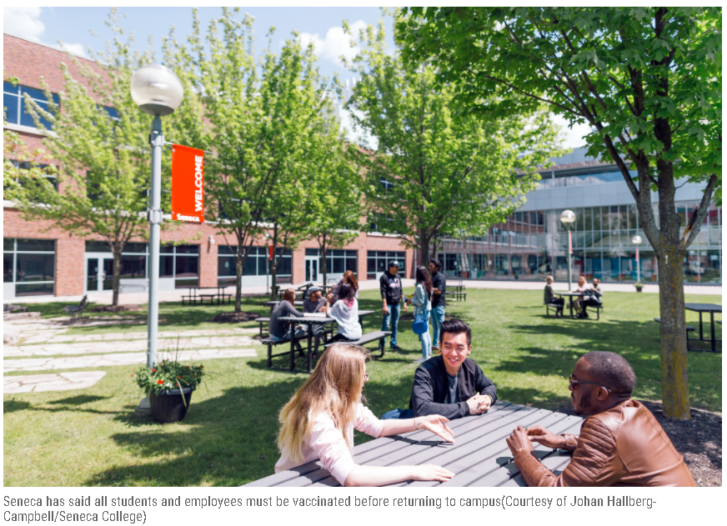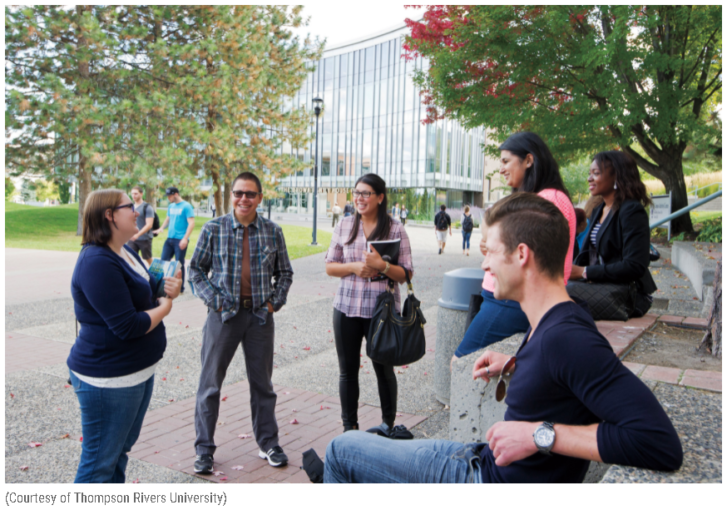This fall marks the return of student life on campus, but not everything will snap back to pre-COVID times. Hybrid models offer the option of online learning, and backup plans are in place in case numbers shoot up again.
Things are looking up at college campuses across Canada. As many areas ease COVID-19 restrictions and vaccination rates continue to climb, schools are once again ready to open their doors and welcome students back to class in person.

But while some aspects of college life might feel like a return to pre-pandemic times, not everything is changing. Most schools are trying to balance the possible need for COVID safety precautions and distance learning with in-real-life study and socializing. Maclean’s surveyed colleges across Canada to find out what lessons were learned from a tumultuous 2020—and what students can expect to see in 2021-22.
The key word is flexibility
Over the course of the pandemic, both students and faculty have discovered the joys and pains of online learning; schools are looking to keep virtual options available for anyone who might prefer them.
But for the most part, whether a class meets online or in person—or a mixture of the two—largely depends on what type of course it is. At Coast Mountain College in Terrace, B.C., trades and nursing programs will be fully in-person, so students can get hands-on experience, while courses in the business or education assistant programs will continue mainly online. Other schools are experimenting with letting students decide which delivery method works best for them throughout the semester. Calgary’s Bow Valley College is calling this approach Hyflex, and students can shift from one to the other as suits their own schedules.
Some colleges have also embraced the opportunity to offer shorter programs, designed to help learners improve their skills and get a stronger footing in the job market. For example, the British Columbia Institute of Technology in Burnaby, B.C., launched microcredential programs in the natural resources and environmental management sectors.
Access services anywhere
It wasn’t just individual classes that moved online during the pandemic. Many services, clubs and social activities did as well, meaning students can access nearly anything they need without stepping on campus. Counselling, library and research support, peer tutoring and even career advice are available online at Fanshawe College in London, Ont. At Mohawk College in Hamilton, a lot of work has gone into making those services more engaging and appealing when students can’t be in the same space together. For instance, peer support tutors have created virtual escape-room quizzes to go over key concepts, and events and seminars on topics like how to apply for college have moved to platforms like Instagram Live.

Campus life is back
Many residences and student dorms will open back up to full capacity this fall, or as near to full capacity as possible. Some schools are setting aside a batch of rooms in case students need areas to self-isolate, and most dorms will still follow social distancing and masking guidelines set out by provincial governments. A few residences are going further, requiring any student who stays in campus housing to show proof of a COVID vaccination. Niagara College, bordering Lake Ontario, requires students living in their dorms to be vaccinated, as does Northern College in Timmins, Ont., which is also barring guests from accessing residence spaces.
Toronto’s Seneca College has made the decision that all students and employees who return to campus this semester are required to be vaccinated. Other institutions are not making vaccines mandatory but are encouraging students to get vaccinated. A handful of schools, like Canadore College in North Bay, Ont., have not yet decided on their vaccine policy and say it could change as the semester unfolds.

Learning lessons outside of the classroom
From a quick pivot to virtual learning, to instituting new cleaning and safety protocols, to helping international students maintain a connection to campus, colleges worked to adapt and grow stronger during the pandemic. Now, those lessons will help guide a still-uncertain 2021-22 school year.
For many, this year has led to bolstering technology and making classes more accessible. The Nova Scotia Community College in Halifax saw how important strong IT support was, and worked to achieve a seamless operation across Nova Scotia while also widening its services, including supports for mental wellness.
It’s widely known the pandemic hit some communities harder than others, with women, Indigenous and Black populations bearing the brunt of the economic and health impacts. Colleges areworking to foster a sense of community on campus and taking a close look at their equity, diversity and inclusion policies. Thompson Rivers University (TRU) in Kamloops, B.C., is recommitting to its inclusion goals, with a federal grant that will go toward identifying and removing systemic barriers to education and implementing findings from TRU’s Anti-Racism Task Force.
More people will be on campus at colleges this fall but safety precautions will still be in place, just in case online learning becomes a public health necessity. Colleges are looking at what worked (and what didn’t) during the pandemic and putting together contingency plans.
If health guidelines change, or new regulations arise, schools won’t be surprised. Instead, they are using what they’ve learned to create yet another new normal, in yet another year unlike any other.
Article From: Maclean’s
Author: Emily Baron Cadloff

